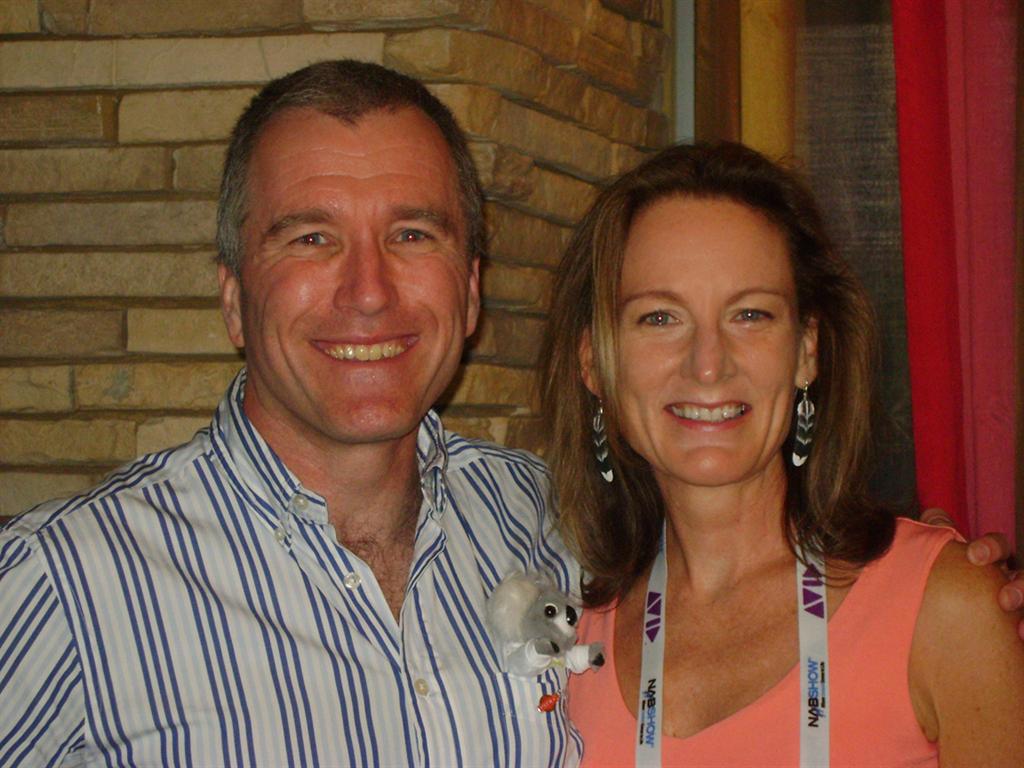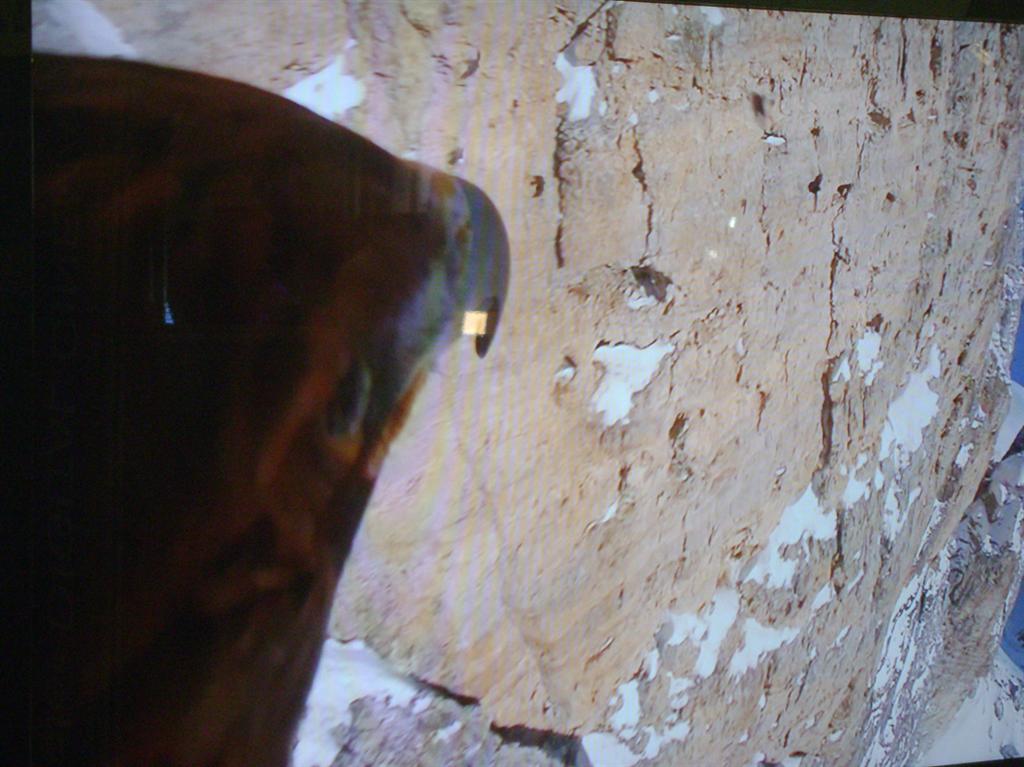McAdams On: NAB 2013

Opening day on the NAB Show exhibit floor, attended by someone in a pink hat.
HOME, SWEET HOME – Another one bites the dust. The 2013 National Association of Broadcasters Show is officially closed. Registration was up about 900 people from last year, to 92,414. I am sorry I didn’t get to talk to all of you.
But I did get to meet Mike Zubeck, director of broadcasting for Muskogee High School in Muskogee, Okla., population 39,000 and home of the Roughers. Mr. Zubeck became the first gentleman at the NAB Show in 13 years to offer me his seat on the Monorail. He was actually one of two this year. Long live civility.
Mike said he was at the NAB looking for gear for the school’s student-produced newscast and schoolwide video network, which is encouraging on two levels: A) a school in a community of 39,000 people has a broadcast program, and B) this industry is concerned about from where the next generation of broadcast technicians are coming. I say “technicians,” but what Bruce Devlin of

Mr. Bob Kovacs, upper right, performs sit-down at the AmberFin breakfast hosted by Mr. Bruce Devlin, at left in the striped shirt.
Amberfin would specify is, “engineers.”
Devlin provided breakfast for a gaggle of reporters at the Renaissance on Wednesday morning to explore that very question, which demonstrates the man’s prowess with journos. Like any other wild creatures, you put out food, and they will come.

Mr. Bruce Devlin, chief technology officer of Amberfin, co-author of MXF and elite bicyclist, and the author.
Since the breakfast came after my encounter with Mr. Zubeck, I was unable to ask him how many people in the program at Muskogee High were disassembling routers to see how they worked. This is usually a pretty good sign there’s an engineer in the room. Mr. Devlin asked if we, too, saw the engineering side of the industry graying. Many of us looked at each other and sucked in our wrinkles.
Yes, of course this is the case, and the question is, how to attract new talent for companies like Amberfin and the work done by Mr. Devlin—who is preternaturally young from bicycling to trade events. One of my most-esteemed competitors, whose company works in partnership with networks, said they have actively recruited interns from tech programs who might otherwise not consider broadcasting a career option until they are walking in a scrum with Tiger Woods.
“You don’t get that at Google,” he said.
Broadcasting also suffers from its own traditional insularity. Bob Kovacs, a team mate of mine and a master of groan-inducing humor, noted how broadcasting and production work was a fairly exclusive club until YouTube blasted into public awareness in the late summer of 2005. Now, even I could make the equivalent of a TV show if I could be bothered.
Unfortunately, broadcasting retains the vestiges of this insularity with its lexicon. This is a common lament among my colleagues: “If I hear the word ‘solution’ one more time,” certain unpleasantries will occur, or words to that effect only far less gracious.
We are deluged, nay, inundated, nay, overwhelmed, nay, swamped and other such synonyms with press releases proclaiming that “Company eXyZee, the world’s leader in cost-effective, real-time, HFR, SD/HD/4K seamless, multicodec, multiformat, nonlinear, platform-agnostic, open-source workflow solutions for the broadcasting, cable, IPTV, production and professional video industry, has enhanced its flagship solution, the eXyZee T64000-72-8-HS-X-541666i. The eXyZee T64000-72-8-HS-X-541666i can now isolate segments for the user for analysis or processing with the new downloadable plug-in available now to users from the eXyZee website.”
This type of language excludes, A) anyone with a shred of respect for the lexicon, and B) everyone else who has no idea what any of this means, which comprises… everyone else. Some of us are, after all, from farms in the Midwest, where E.B. White would have been considered “kinda chatty.”
There is a similar elusive nature to operations language. The word “workflow” is not in any of the dictionaries I consult. Clarity and accessibility should be a goal of this industry for two imperatives: To attract new talent, and so that lawmakers don’t just hand the broadcast spectrum to wireless providers because the TV industry can’t explain its technical side in 200 English words or less.
Which brings us to another theme of the big broadcast show that just was—the TV spectrum incentive auction. Two of the three members of the Federal Communications Commission who are not retiring soon subjected themselves to a Q&A panel. Both Jessica Rosenworcel and Ajit Pai have demonstrated their awareness of the complexity of the auction—the first of its type. I.e., anonymous broadcasters will offer all or a portion of their spectrum in a “reverse” auction to determine the value of that license and whether or not they wish to participate in a “forward” auction that’s actually a real auction. Participant licensees are supposed to get a chunk of the auction proceeds, but no one knows how much.
Jim Condon of the Vermont Association of Broadcasters asked “what certainty” border broadcasters would have that the interference treaties would be worked out with Canada and Mexico before the post-auction channel repacking.
Rosenworcel, a potential contender for the eighth-floor office, said the statute requires it and that it was her “intention that the FCC does so.” She also mentioned that the FCC needs to add engineers. I nominate the good Mr. Devlin.
Pai, a native of Kansas, will be the best friend of low-power and translator stations, because he is from Tornado Alley and has a clue what they do. This should come as some relief to Paula Maes, president and CEO of the New Mexico Broadcasters Association. The state has 270 translators serving a very large portion of the population. There is also concern among Arizona’s Gila River Indian Community, which is building out its own network on LPTV licenses. Neither non-Class A LPTVs nor translators have interference protection and feasibly could be repacked out of existence. This did not seem to be something the two junior commissioners cared to have on their CVs.
The outgoing FCC chairman, Julius Genachowski also spoke at the show, but he did not have the pleasure of seeing me as I was on deadline because my cloning project remains in beta. My long-time friend who works for that really busy station group summed up the chairman’s message thus: “Giving the TV spectrum to

Mr. Jay Coley, founder and chief of Editware and former fitness student of the author.
the wireless industry will be good for broadcasters, because then they can just get the providers to carry them.”
Well, okey-dokey.
Then there was the floor… that other part of the show, which could use more integration with the talking-head stuff. In other words, it would be nice to see the regulator interview on a raised stage in Central Hall. Or at least have giant display screens in each of the halls so that there’s less of a segregated feeling to the show. (And does there have to be more sessions than planets in the known solar system? Does there? Really?)
The floor. Buzzwords=HEVC, 4K, function collapse, the SDI-to-IP migration and of course, “cloud.”
Reporters at the Snell presser chased down Fox’s Clyde Smith after he said the network would put master control in the cloud—someday. Once the connection standards are hammered out. Granted, that wasn’t from the floor, but it highlighted Snell’s virtualized playout system being demoed there.
Another non-floor aside—Sony made the unusual move of announcing the price on consumer gear unveiled at CES—a 55-inch 4KTV for $4,999 and a 65-incher for $6,999, available for order April 21. At the booth, the Japanese electronics giant demonstrated that it is not abandoning organic light-emitting diode technology with a 4K OLED monitor.
Over in North Hall, David Ross of Ross Video was having a “rossome” show, with a 20 percent increase in traffic. He agreed to buy me a beer if I work the word “rossome” into a headline, which shouldn’t be too hard, since this is the Internet.
Marco Lopez, president of Miranda, was also in North Hall and also had a 20 percent bump in traffic. Mr. Lopez said the SDI-to-IP transition was the “next technical challenge” of the industry, and it would likely take 10 years and involve a period of hybrid equipment. These type of fluid product development periods are now the rule for vendors rather than the exception. The same goes for networks and production operations. Frank Governale, vice president of operations for CBS News said developing the workflow was “never done.”
The other challenge for vendors is the function-collapse phenomenon. Everyone is looking for smaller gear that does more stuff. Mr. Lopez said 4K will disrupt that trend—at least for a while. Bandwidth is now the chokepoint for 4K, but, as he said, “we’ve seen this all before,” when the industry went from SD to HD.
I didn’t get to spend nearly enough time on the floor, par usual, but there was plenty to pique the interest of the folks I talked to. Tom McMahon liked the 3Monkey 3D display touch screen, the Fraunhofer tri-focal 3D camera with depth of field, and the Vanguard Video real-time HEVC encoder/decoder running on a PC. Another friend mentioned a company called “Counterpoint” doing “rights management at a granular level.”
My top spy mentioned that Ikegami was using an ARRI chip in a broadcast camera, and that Hitachi was showing a small 8K camera. Dolby was said to have a 10,000-nit, water-cooled display in their booth, but my sources are bound to secrecy and would not confirm that it was between 9,999 and 10,001 nits, so I am dodgey on actual nittage, and their corneas are intact. Clyde Smith said he dissed 22.2 surround sound until he heard it at the Futures Park and now wants it.

What an eagle in flight sees, courtesy of Fraunhofer. Please hire us.
Fraunhofer enchanted me with the Eagle Cam, a sub-one-inch square HD camera strapped to the neck of a trained eagle like a GoPro. The footage showed what it was like to be an eagle. Extreme wingsuiters? Puh-lease.
My floor time ended before I was able to see everyone I would have liked, so my sincere apologies to Blake Homan, president of Video Clarity, my friend Brad Harrison at Wheatstone (I came by—you were with a client) and others whom I missed--Larry and Dave at JVC, Tim at Linear, Mr. and Mrs. Paulsen, Lan Merrill, et al. Your support is very much appreciated.
My sympathies to those who slept on the floor at McCarran waiting for a flight. I arrived home safely and awoke this morning to birdsong instead of jackhammers.
See you again next year.
The professional video industry's #1 source for news, trends and product and tech information. Sign up below.
